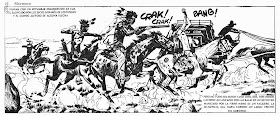Héctor Germán Oesterheld (w) and Hugo Pratt (a), "Rastros de fuego" [fire tracks], Misterix # 238, April 10, 1953 (page 72 of the series).
Héctor Germán Oesterheld (w) and Hugo Pratt (a): the same panel as published in Sgt. Kirk # 5, November, 1967.
As you can see the 1967 version is a lot more cramped than the 1953 one (somehow the stagecoach travels faster in the first example: the rocks and the panel border on the left squeeze it in the second version). The tree on the right side of the panel helps to underline what Oesterheld wrote on the caption (once again, said caption was completely destroyed by Pratt in his Sgt. Kirk version):
As a matter of fact, appearing as if from inside a surprise box...
John Ford (d), Bert Glennon (p), Stagecoach, Walter Wanger, 1939.
During the attack John Ford (d), Otto Lovering (e), Dorothy Spencer (e), Walter Reynolds (e), do cross-cuttings between the interior and the exterior of the stagecoach. Oesterheld and Pratt do cross-cuttings between the attack (we never see the stagecoach's interior) and Maha, Kirk, and five more Tchatogas, who are watching from a distance (they participate in the action at the end, when the stagecoach reaches them).
Hugo Pratt drew a couple more spectacular images of the chase (see below):
Héctor Germán Oesterheld (w) and Hugo Pratt (a), "Rastros de fuego" [fire tracks], Misterix # 238, April 10, 1953 (page 74 of the series).
John Ford (d), Bert Glennon (p), Stagecoach, Walter Wanger, 1939.
As we can see in the film frame above, the image loses readability because of the dust. John Ford chose a flat, but dusty land to film. Not being (much, anyway) constrained by the laws of physics, Pratt didn't eliminate dust, but he controlled it as he pleased...
To avoid the dust John Ford also filmed with the camera shooting ahead of the stagecoach:
In both the film and the comic, Indians fall:
Héctor Germán Oesterheld (w) and Hugo Pratt (a), "El brujo blanco" [the white wizard], Misterix # 239, April 17, 1953 (page 77 of the series).
John Ford (d), Bert Glennon (p), Stagecoach, Walter Wanger, 1939.
In the two examples above there's a subtle difference though: the profile shot is neutral (even if we know that the plot is on the deffenders' side); the front shot below puts the viewers on the stagecoach travellers' place (the Apaches are unequivocally, "the other threatening us").
Maybe the most famous shot in this Stagecoach sequence is the extreme low angle in which the camera was put in a hole (see below):
John Ford (d), Bert Glennon (p), Stagecoach, Walter Wanger, 1939.
Someone should explain this to me though: the Indians don't shoot one of the horses pulling the stagecoach why exactly? It would effectively and easily stop it in a complete disaster. I don't know who said that in a bad story everybody is stupid (Peter David?).










No comments:
Post a Comment